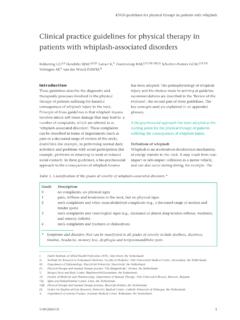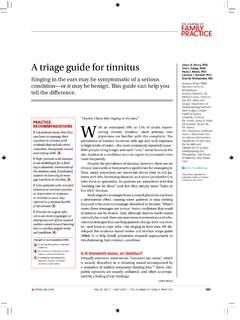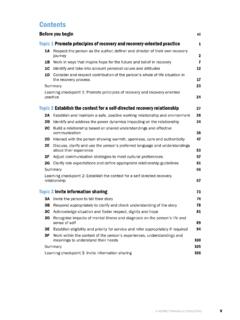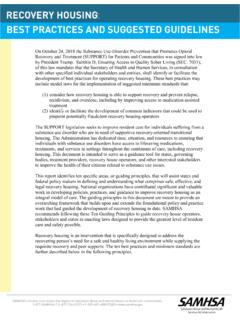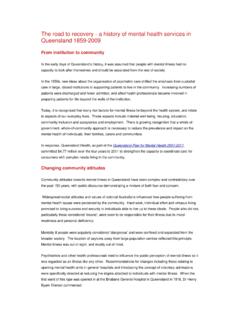Transcription of Clinical practice guidelines for physical therapy in ...
1 KNGF- guidelines for physical therapy in patients with whiplash Clinical practice guidelines for physical therapy in patients with whiplash-associated disorders Bekkering GE,I,II Hendriks HJM,I,III,IV Lanser K,V Oostendorp RAB,I,VI,VII,VIII,IX Scholten-Peeters GGM,I,VI,VII. Verhagen AP,X van der Windt Introduction has been adopted. The pathophysiology of whiplash These guidelines describe the diagnostic and injury and the choices made in arriving at guideline therapeutic processes involved in the physical recommendations are described in the Review of the therapy of patients suffering the harmful evidence', the second part of these guidelines . The consequences of whiplash injury to the neck. key concepts used are explained in an appended Principle of these guidelines is that whiplash trauma glossary.
2 Involves minor soft tissue damage that may lead to a number of complaints, which are referred to as A bio-psychosocial approach has been adopted as the whiplash-associated disorders'. These complaints starting point for the physical therapy of patients can be described in terms of impairments (such as suffering the consequences of whiplash injury. pain or a decreased range of motion of the neck), disabilities (for example, in performing normal daily Definition of whiplash activities) and problems with social participation (for Whiplash is an acceleration-deceleration mechanism example, problems in returning to work or reduced of energy transfer to the neck. It may result from rear- social contact). In these guidelines , a bio-psychosocial impact or side-impact collisions in a motor vehicle, approach to the consequences of whiplash trauma and can also occur during diving, for example.
3 The Table 1. Classification of the grades of severity of whiplash-associated disorders.*. Grade Description 0 no complaints, no physical signs 1 pain, stiffness and tenderness in the neck, but no physical signs 2 neck complaints and other musculoskeletal complaints ( , a decreased range of motion and tender spots). 3 neck complaints and neurological signs ( , decreased or absent deep tendon reflexes, weakness, and sensory deficits). 4 neck complaints and fractures or dislocations * Symptoms and disorders that can be manifested in all grades of severity include deafness, dizziness, tinnitus, headache, memory loss, dysphagia and temporomandibular pain. I. Dutch Institute of Allied Health Professions (NPi), Amersfoort, the Netherlands II.
4 Institute for Research in Extramural Medicine, Faculty of Medicine, Vrije Universiteit Medical Center, Amsterdam, the Netherlands III. Department of Epidemiology, Maastricht University, Maastricht, the Netherlands IV. physical therapy and manual therapy practice The Klepperheide', Druten, the Netherlands V. Integral Neck and Back Center, Hardinxveld-Giessendam, the Netherlands VI. Faculty of Medicine and Pharmacology, Department of Manual therapy , Vrije Universiteit Brussel, Brussels, Belgium VII. Spine and Rehabilitation Center, Uden, the Netherlands VIII. physical therapy and manual therapy practice , Heeswijk-Dinther, the Netherlands IX. Center for Quality-of-Care Research, University Medical Center, Catholic University of Nijmegen, the Netherlands X.
5 Department of General practice , Erasmus Medical Center Rotterdam, the Netherlands V-09/2003/US 1. KNGF- guidelines for physical therapy in patients with whiplash impact may result in injury to bony or soft tissue ( , Prognosis whiplash injury), which in turn may lead to a variety There is no consensus in the literature on the of Clinical manifestations. Frequently occurring prognosis of the consequences of whiplash. The symptoms are neck pain, decreased mobility of the prevalence of long-term complaints ( , from six cervical spine, headache, and dizziness. The Clinical months to two years) varies from 19 60%. A. symptoms, which are known as whiplash-associated Canadian research group, the Quebec Task Force on disorders, can be classified into five grades of severity whiplash-associated disorders (QTF-WAD), reported that (Table 1).
6 These guidelines concentrate on patients the prognosis is favorable: around 85% of patients with grade-1 and 2 whiplash-associated disorders. return to work within six months after the whiplash Patients with neurological signs, fractures or injury. Recently, this conclusion has been criticized dislocations are not covered by these. because the severity and duration of the complaints may have been underestimated. In addition, the time that has passed since the injury can be divided into six phases: less than four days; Normal and delayed recovery four days to three weeks; three to six weeks; six weeks A distinction is made between patients who undergo to three months; three months to six months, and normal recovery and those who undergo delayed more than six months.
7 In these guidelines , the time recovery after whiplash injury. Normal recovery refers that has passed since the injury is related to the to the average' or expected' course of recovery from consequences of whiplash. the consequences of whiplash. Normally, over time the patient's functions improve, the patient's levels of Epidemiology activity and participation increase, and the patient's Epidemiological data on the incidence of whiplash pain level declines. Moreover, there is some are mainly derived from insurance claim numbers. interrelationship between impairments, disabilities Therefore, the reported annual incidence of whiplash and participation problems. When recovery is varies widely between countries and continents: delayed, it may be that the patient's functions do figures vary from 16 per 100,000 inhabitants each not improve or the patient's levels of activity and year in New Zealand to 70 per 100,000 inhabitants participation do not increase or the patient's pain each year in Quebec, Canada.
8 In the Netherlands, the level does not decline with time. Moreover, the number of new patients who have experienced interrelationship between impairments, disabilities whiplash is estimated to be 94 188 per 100,000 and participation problems is less obvious. In the inhabitants each year. These figures are much higher working group's view, recovery can be said to be than international estimates because they are derived delayed if a patient suffering the consequences of from accident statistics. There are no Dutch data on whiplash shows no progress in terms of levels of the prevalence of specific symptoms after whiplash. activity and participation within four weeks. Table 2. Prognostic factors associated with delayed recovery after whiplash.
9 Whiplash-related factors: decreased mobility of the neck immediately after injury;. pre-existing head trauma;. female gender;. volder age. Factors related to chronic pain: coping strategy;*. psychosocial factors ( , passive coping, fear or job dissatisfaction). * can be influenced by physical therapy 2 V-09/2003/US. KNGF- guidelines for physical therapy in patients with whiplash With normal recovery , activity and participation Role of the physical therapist levels increase over time. This is not the case with The general objectives of physical therapy are to delayed recovery . enable the patient suffering the consequences of whiplash to return to normal, or desired, levels of Prognostic factors activity and participation, and to prevent the A number of factors are associated with delayed development of chronic complaints.
10 recovery after whiplash injury (Table 2). The first four factors listed in the table are related to whiplash; the In the first three weeks after whiplash, the physical last two factors concern chronic pain in general. therapist should observe the patient and should take actions that encourage recovery from the injury to Coping strategy follow a natural course. From three to six weeks after During recovery , patients may cope with their whiplash, the physical therapist should, if necessary, complaints either adequately or inadequately. Coping try to modify the patient's coping strategy using is connected with the extent to which a person is able behavior- oriented principles that focus on the to adjust his* load ( , what he wishes to do) to his patient's functioning.
